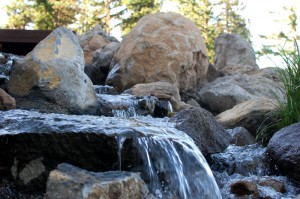By Ben Bowen
All water features have similar “bones”. How you flesh them out makes the difference.
 In the last two decades the landscape water feature has become a common element in residential designs. As a result, more and more landscapers and homeowners are trying their hand at designing and installing them. In the past, just knowing how to build a water feature set you apart as a landscape contractor. Not anymore. Does that mean the opportunity is gone?
In the last two decades the landscape water feature has become a common element in residential designs. As a result, more and more landscapers and homeowners are trying their hand at designing and installing them. In the past, just knowing how to build a water feature set you apart as a landscape contractor. Not anymore. Does that mean the opportunity is gone?
Not at all. Many of the ponds and fountains built in the last decade are low quality. They are built by landscapers following a “water-feature-by-numbers” approach learned at a one day class taught by a supplier. These features have running water, perfect cascades, and no leaks- all good things. But what do they look like? Do they resemble nature at all?
Herein lies the way to differentiate yourself: design and craft naturally beautiful water features. With a portfolio full of stunning falls and cascades you will sell more water features, and be able to get more for them. It takes practice and dedication to master this, but these tips will get you started in the right direction.
-
Control your ambitions. Your client wants falls. Big falls, as many as possible. You don’t have a lot of room to work with, but you go for it. You build a retaining wall, pile up the soil, and get rolling. Now you have a mound of soil as big as your truck and no way to hide it. You may not even be able to camouflage the retaining! Avoid this trap. Take the stream only as high as you reasonably can. You need space to work with if you are going to convince people that the stream is cascading down a natural slope.
-
Natural stone falls. Streams and rivers, in nature, are unruly. They do not have perfect sheets of water spilling over flat rocks. Neither should your water features. Use rough, natural stone for your waterfalls and cascades.
-
Hide the bones. Skimmers, pumps, filters- all are part of a quality project. Take the time and care to hide all of these. It should be difficult for the average person to look at your pond and locate the pump. Use rocks, plants, and terrain to keep all of these invisible.
-
Go big. Wait, didn’t I say to control your ambitions? Not when it comes to the size of rock you use. Use the biggest boulders you possibly can. This may mean using a tractor or crane to set the largest in place. Once the water and plants are in place they will not look nearly so large. Whatever you do, don’t build the whole thing out of basketball-sized rocks.
-
Bring the green. Your design should include an abundance of places for plants. Obviously you will be able to plant around the feature. Allow for plantings in the water feature too. Create planting pockets in the stream, at the base of larger rocks, and in the pond. This will allow you to soften all the stone you have to use and you won’t just be setting plants in pots under the water.
-
Be a copycat. Become a water feature critic, an expert. Look at every pond, waterfall, and fountain you can. Observe how other landscapers build great features. Look to mother nature as well. Be inspired by the real thing and do your best to emulate it.
Use these 6 tips as a starting point. Plan on taking enough time to do your next water feature project right. You will soon have your own list of tools, materials, methods, and principle that you can deploy to create naturally stunning water features.


